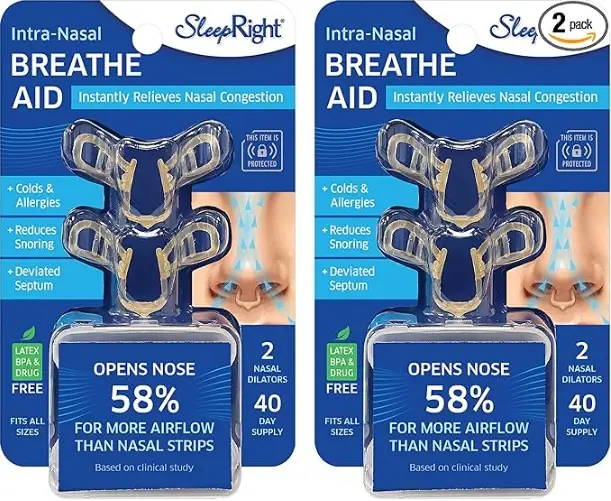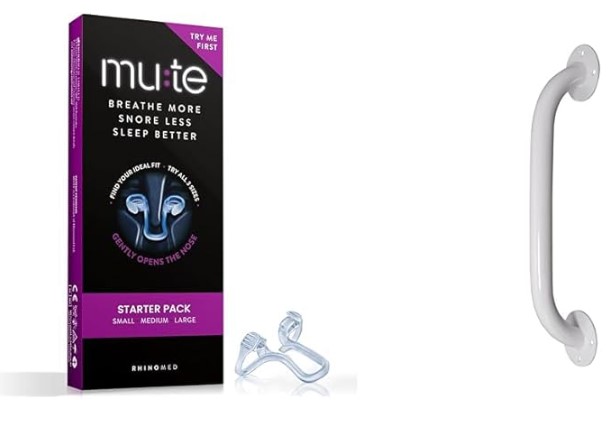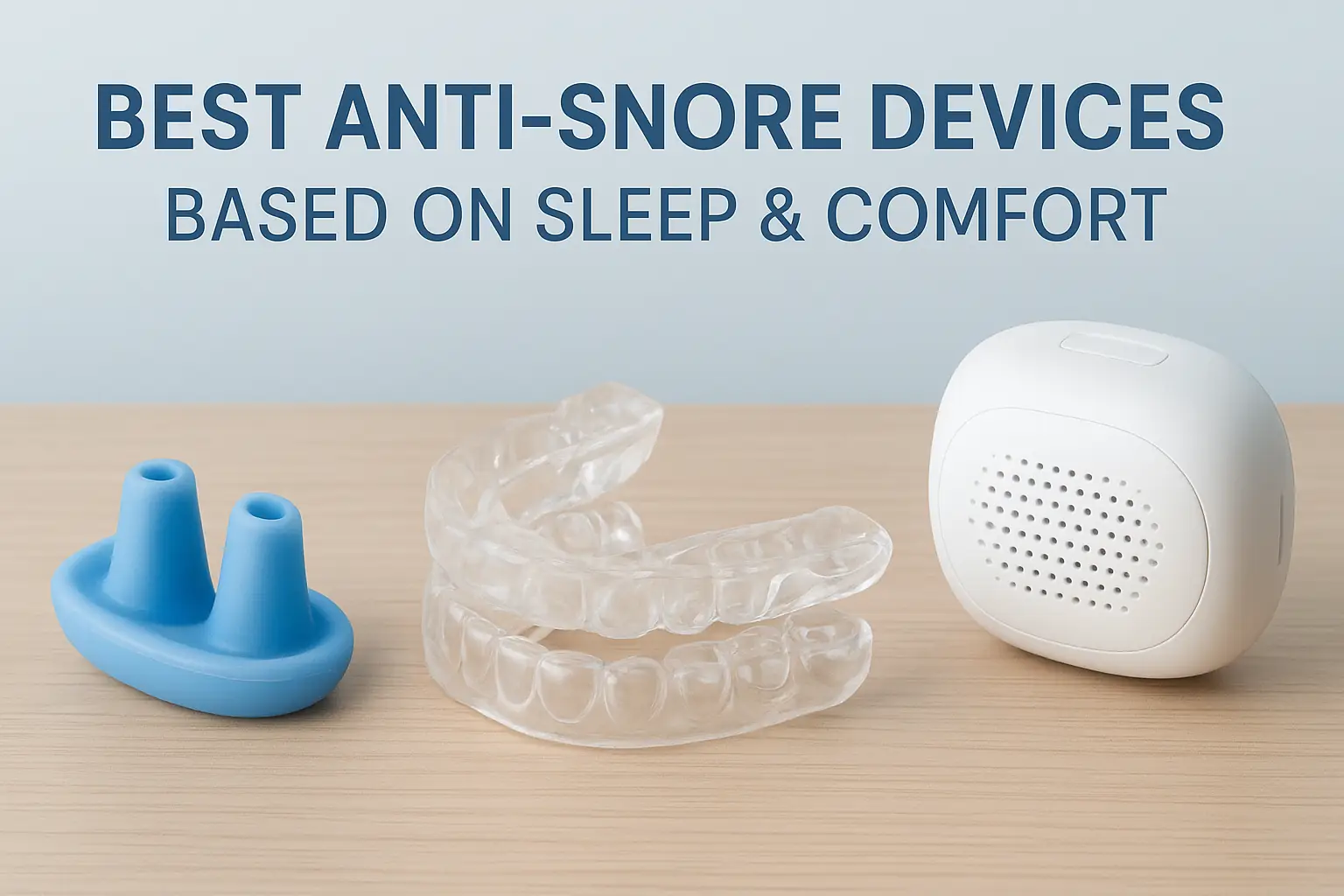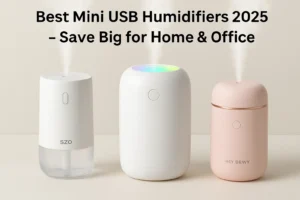Snoring can disturb your sleep and others too.Simple tools can help you breathe better at night. Here are some top anti-snore devices on Amazon. Anti-snore tools open your airway while sleeping. They include nasal strips, mouthpieces, chin straps and pillows. Mouthpieces gently move the jaw forward, improving airflow. Nasal strips lift open nose passages so you breathe easier. Chin straps keep your mouth closed so you don’t breathe through it. Smart pillows adjust your head or neck to stop airway collapse. Choosing a device depends on your snoring type and comfort level. If devices don’t help, see a doctor—snoring may mean sleep apnea.
1. Nasal Dilator
Open your nose for easy airflow. It normally widens the nasal passages because of allowing more oxygen. Reduces noise and helps deep sleep. Soft and comfy to wear all night. It opens narrow nasal airways for easier breathing. It works externally or is placed inside the nostrils. Some studies show it reduces snoring caused by nasal blockage. It’s best when nasal congestion or a narrow nasal valve is present. It’s not a full fix for severe sleep-apnoea or throat obstruction. Simple, drug-free aid to improve nasal breathing at night. It is an effective aid for easier breathing and better sleep quality.

See More
What is a Nasal Dilator Snore Reducer?
Snoring often starts with restricted airflow through the nasal passages. A nasal dilator snore reducer is a device designed to gently widen (dilate) the nostrils or nasal airway during sleep — allowing more air to pass and reducing the vibration that causes snoring. These devices are typically inserted into or placed over the nose, are non-invasive, drug-free, and aim to improve breathing, airway openness, and ultimately sleep quality.
They are especially useful for people whose snoring is triggered by nasal congestion, a narrow nasal passage, or simple nasal-based airway obstruction. Unlike mouthguards or chin straps, nasal dilators target the nose specifically — which can be a more comfortable and less intrusive option for many users.
When choosing one, factors like fit, comfort, material, how well it stays in place while you move, and how much airflow improvement it gives are critical. In the sections below you’ll find five strong options we found on Amazon, along with their details to help you decide which fits you best.
Top Nasal Dilator Snore Reducer Products

1. Rhinomed “Mute Nasal Dilator” (Medium 3-Pack)
-
Product Type: Internal nasal dilator (stent style)
-
Best For: Users with moderate nasal-snoring, those seeking discreet internal solution
-
Key Features:
-
Increases nasal airflow ~38% compared to nasal strips.
-
Adjustable left & right stents for customised fit.
-
Clear/mostly internal design for minimal visibility.
-
Reusable up to ~10 nights if cleaned properly.
-
-
Pros:
-
Strong airflow improvement
-
Discreet and internal (less visible)
-
Reusable (reduces cost per night)
-
-
Cons:
-
Need to find correct size for optimal fit
-
Internal fit may feel uncomfortable for some side-sleepers initially
-
Cleaning & reuse required (maintenance)
-
-
Price Range: Approx $32.98 (varies by pack/size)
-
Specifications:
-
Sizes: Small, Medium, Large included in Starter Pack.
-
Dimensions: ~6.49 × 2.36 × 0.78 inches; weight ~1.13 oz.
- Material: Medical-grade biocompatible polymer.
-
2. Anti-Snore Nose Strips
These strips lift the sides of the nose for better airflow. They stick across the nose bridge and flare the nostrils outward. They are best for snoring caused by nasal congestion or narrow nasal valves. They are drug-free and easy to use at night. They don’t fix snoring from throat tissue collapse or full sleep apnoea. Cleansed, dry skin improves adhesion and performance. They offer a simple, low-risk way to try breathing better in sleeping time. Basically Nose strips are stuck on the nose before sleep for smooth breathing because they lift the nasal passages.
3. Mouth Guard (Mandibular Device)
The mandibular device fits inside the mouth and normally moves the lower jaw forward slightly. It prevents the tongue and soft throat tissues from collapsing into the airway. Studies show it widens the upper breathing tube at the same time reduces snoring and breathing interruptions. It works best for people with mild to moderate airway obstruction. But not for major jaw issues. It is drug-free, and many users find it more comfortable than mask-based machines. However, some people may feel jaw ache, tooth sensitivity or increased drooling at first—these seldom last long. It’s important to use it nightly and keep regular check-ups with a dentist to make sure it keeps fitting right. In a word, keep your jaw slightly forward. Stops tongue from blocking airways. Helps reduce loud and heavy snoring.
4. Chin Strap
A chin strap keeps the mouth shut while doingze. It encourages nose-only breathing instead of mouth breathing. It holds the lower jaw in place during sleep. Fabric is soft and flexible for gentle nightly support. It may reduce snoring caused by open mouth breathing. Best for users whose snoring comes from mouth opening. It is not a proven cure-all for sleep apnoea. Check that the nose airway is clear before use. Always consult a sleep specialist if breathing pauses occur. In other words, keep your mouth closed while you sleep. Helps you breathe through your nose. Made of soft, stretchable fabric for comfort.
5. Anti-Snore Pillow
An anti-snore pillow helps anyone’s head and neck. It keeps the neck straight in deep sleeping time. Lifts head slightly to improve airflow naturally. Special foam or contours reduce throat vibration. Users may report quieter sleep and fewer awakenings. For posture issues, It works best for snoring. In Sleeping time, It helps the mild airway to narrow. Not suitable for severe sleep apnea cases. Selecting the right height improves side and back comfort. For proper breathing alignment at night, it matters firmness. Many pillows come with hypoallergenic washable covers. Better pillows adjust your head quietly during snoring. Helps calm, restful, and comfort sleep. A simple non-invasive tool is used for better breathing. It is ideal for reducing snores and comfortable support. In other words, support your head and neck better. Encourages side sleeping for quiet nights. Works great with other snoring aids.
6. Humidifier
A humidifier normally adds moisture to dry bedroom air. It helps to keep the throat and nasal passages. Usually bedroom dry air can distemper the bedroom areas that’s why snoring occurs. By using a humidifier, you can increase the humidity in your bedroom temperature. It is especially helpful in winter or dry climates. Many people notice less snoring and better sleep. However, it is not a cure for serious conditions like sleep apnea. If snoring continues, consult a doctor. Regular cleaning of the humidifier is important to prevent mold and bacteria. A humidity level of 30–50% is ideal so manage humidity level to reduce snore sound and help people sleep comfortably.
In summary, a humidifier can help reduce snoring when existing in dry air. It is a simple, non-invasive solution to improve sleep quality.


Pingback: Best Mini USB Humidifiers 2025 – Save Big for Home & Office
Pingback: Best Electric Heating Waist Massager Belt – Back Pain Relief